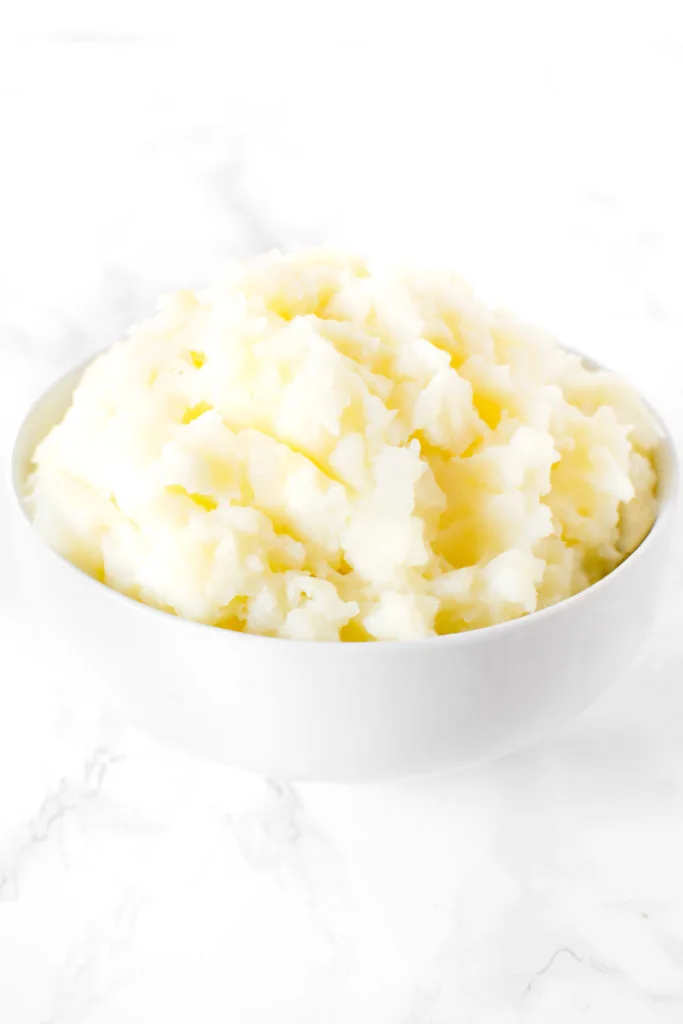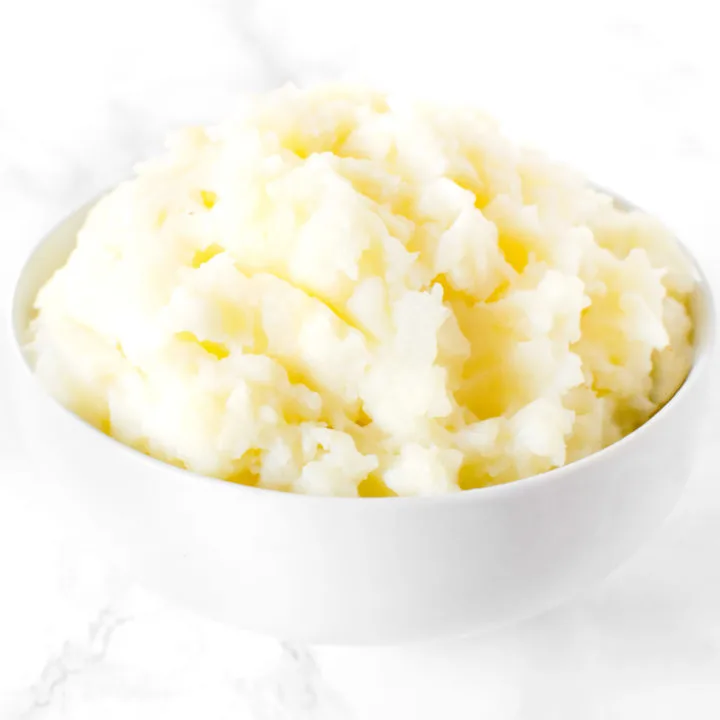These coconut milk mashed potatoes are dairy free and incredibly creamy!
Honestly, it's really hard to tell the difference between these mashed potatoes and dairy ones...

I don't know what it is with me and mashed potatoes, but I regularly find myself trying and developing new dairy free recipes for them.
I've made my mashed potatoes without milk which use mayonnaise, stock, and garlic which were really good!
Then, I made mashed potatoes without butter which use garlic and olive oil.
Next were mashed potatoes with almond milk and mashed potatoes with oat milk.
I've even made dairy free mashed sweet potatoes and dairy free mixed mashed potatoes, which use both white and sweet potatoes.
Now, in my never ending journey with dairy free mashed potatoes, I've made these mashed potatoes with coconut milk.
Don't worry though, these coconut milk mashed potatoes, just like my pumpkin pie with coconut milk, don't have any coconut flavor at all!
In fact, I'd be surprised if you can taste the difference between these mashed potatoes and dairy ones...
History of Mashed Potatoes
While rice was imported into Europe since ancient times (brought from Asia by returning soldiers from Alexander the Great's military and later imported from Egypt), potatoes, while commonly associated with Ireland, were brought to Europe by the Spanish in the second half of the 1500's.
Potatoes became an international staple because they were cheap to grow and high in nutrition.
They are a rich source of vitamin B6 and vitamin C, providing almost 25% of your daily value of each.
Potatoes are very versatile and mashed potatoes are arguably the most common way they are prepared and eaten.
The first recipe for mashed potatoes first appeared in The Art of Cookery by Hannah Glasse in 1747.
Boil your Potatoes, peel them, and put them into a Sauce-pan, mash them well: To two Pounds of Potatoes put a Pint of Milk, a little Salt, stir them well together, take care they don’t stick to the Bottom, then take a quarter of a Pound of Butter, stir in and serve it up.
While the Art of Cookery originated in England, it was very popular in the Thirteen Colonies as well in America after the War of Independence.
In fact, Benjamin Franklin, Thomas Jefferson, and George Washington all owned copies of it.
About Dairy Free Mashed Potatoes
While mashed potatoes don't have to contain dairy, they almost always do.
Most mashed potato recipes include milk, buttermilk, cream, butter, sour cream, and/or cheese.
You can make mashed potatoes without milk by replacing it with another liquid such as almond milk, oat milk, coconut milk, reserved starchy water, regular water, chicken stock, or vegetable stock.
It doesn't really make a difference if you use milk, water, or any other liquid because one isn't necessarily better than the other.
To replace buttermilk in mashed potatoes, substitute it with dairy free buttermilk by using buttermilk made with oat milk or buttermilk made with almond milk.
To make mashed potatoes without butter, you need to substitute the fat in butter with another form of fat, like oil.
Mayonnaise is also a surprisingly good substitute for butter and sour cream in mashed potatoes.
What can I use in place of milk in mashed potatoes?
Milk can be replaced with water or dairy free milk in mashed potatoes. This recipe uses coconut milk.
How to make creamy mashed potatoes without milk?
Additions like dairy free milk, coconut cream, almond cooking milk, water, and mayonnaise can all help make something creamy without dairy.
What you use really depends on what you are making. With dairy free mashed potatoes, any of these options work.
Milk actually doesn't make mashed potatoes super creamy. It mostly just adds liquid so the potatoes aren't dry.
It is the addition of fat that makes mashed potatoes and other dishes creamy.
This fat usually appears in the form of butter, or sometimes cream cheese or even sour cream.
However, you can use other forms of fat such as oil to get that creaminess.
To make them extra creamy, add a little bit of mayonnaise like I do in this recipe. You won't taste the mayonnaise, but the mashed potatoes will be oh so creamy!
DO YOU PEAL POTATOES BEFORE BOILING FOR MASHED POTATOES?
You can, but you don’t have to. Potatoes that have clean skin can be washed and left on.
I like leaving the skins on, but I choose which way to do it based on the preferences of whoever else will be eating it.
TYPES OF POTATOES
There are generally three types of potatoes: waxy, starchy, and those in between.
WAXY
Waxy potatoes, such as Red Bliss and fingerlings, have a smooth skin and creamy, almost shiny flesh.
Because waxy potatoes are relatively low in starch and high in moisture, they stay intact when they’re cooked.
STARCHY AKA FLOURY
The most common example of starchy potato are russets, A.K.A. Idaho potatoes.
As you may have guessed by their name, they’re higher in starch and lower in moisture than waxy potatoes. They are matte-skinned and fall apart when boiled.
Starchy potatoes are ideal for adding creaminess to puréed soups or providing the airy, whipped texture to a mash. They are also good for roasting and frying.
IN-BETWEEN
These fall somewhere between the waxy and floury, making them the “all-purpose” potatoes. The most commonly known of them are Yukon Golds.
Because they hold their shape when boiled, grated, or fried, and yield to mashing, they’re very versatile.
BEST FOR MASHED POTATOES
Since the waxy are most flavorful but the starchy are airiest, for the ideal mashed potatoes use half and half. This is a tip I picked up from the New York Times.
However, if you could only choose one, choose the in between option like Yukon Gold.
Or, if where you live you don’t have any clear way to know what type of potato you have available, use whatever you have.
WATER TEMPERATURE
Believe it or not, it’s best to begin cooking potatoes in cold water. It doesn’t have to be chilled, just the cold side from the tap.
While this may sound counterintuitive, cold water helps the potatoes cook more evenly.
Also, if it’s better that way, why waste the gas and cooking time by boiling the water?
How To Store
Place in an airtight container or leave in a bowl and wrap in plastic wrap and refrigerate.
Coconut Milk Mashed Potatoes

These coconut milk mashed potatoes are dairy free and vegan, but taste just like your classic dairy mashed potatoes!
Ingredients
- 1 ½ pounds potatoes, peeled and cubed
- ½ teaspoon salt
- 4 tablespoons coconut milk
- 2 tablespoons vegan butter
Instructions
- Place potatoes into a pot and add cold water until there is an inch of water above the top of the potatoes.
- Bring water to a boil, then reduce to a simmer. Cook for 15 to 20 minutes, or until you can easily poke through the potatoes with a fork.
- While the potatoes are cooking, warm the coconut milk and vegan butter in a sauce pan until the vegan butter melts.
- When the potatoes are done, drain and set aside the starchy water.
- Pour the heated coconut milk and melted vegan butter over the potatoes.
- If the potatoes seem a little dry, add the starchy water back to the potatoes a tablespoon at a time and mash until the mashed potatoes are smooth.
- Add salt to taste.
Nutrition Information:
Yield:
4Serving Size:
1Amount Per Serving: Calories: 237Total Fat: 9gSaturated Fat: 4gTrans Fat: 1gUnsaturated Fat: 5gCholesterol: 0mgSodium: 283mgCarbohydrates: 36gFiber: 4gSugar: 2gProtein: 5g